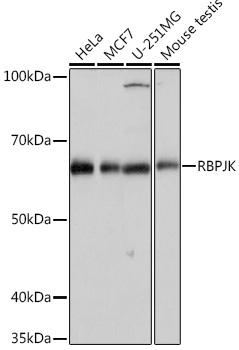Anti-RBPJK Antibody (CAB4081)
- SKU:
- CAB4081
- Product type:
- Antibody
- Reactivity:
- Human
- Reactivity:
- Mouse
- Host Species:
- Rabbit
- Isotype:
- IgG
- Research Area:
- Signal Transduction
Description
| 抗体名: | Anti-RBPJK Antibody |
| 抗体コード: | CAB4081 |
| 抗体サイズ: | 20uL, 50uL, 100uL |
| 申し込み: | WB |
| 反応性: | Human, Mouse |
| 宿主種: | Rabbit |
| 免疫原: | A synthesized peptide derived from human RBPJK |
| 申し込み: | WB |
| 推奨希釈: | WB 1:500 - 1:2000 |
| 反応性: | Human, Mouse |
| ポジティブサンプル: | HeLa, MCF7, U-251MG, Mouse testis |
| 免疫原: | A synthesized peptide derived from human RBPJK |
| 精製方法: | Affinity purification |
| ストレージバッファ: | Store at -20'C. Avoid freeze / thaw cycles. Buffer: PBS with 0.02% sodium azide, 0.05% BSA, 50% glycerol, pH7.3. |
| アイソタイプ: | IgG |
| 順序: | Email for sequence |
| 遺伝子ID: | 3516 |
| Uniprot: | Q06330 |
| セルラーロケーション: | |
| 計算された分子量: | 60kDa |
| 観察された分子量: | 67KDa |
| 同義語: | AOS3, CBF1, IGKJRB, IGKJRB1, KBF2, RBP-J, RBPJK, RBPSUH, SUH, csl |
| バックグラウンド: | The protein encoded by this gene is a transcriptional regulator important in the Notch signaling pathway. The encoded protein acts as a repressor when not bound to Notch proteins and an activator when bound to Notch proteins. It is thought to function by recruiting chromatin remodeling complexes containing histone deacetylase or histone acetylase proteins to Notch signaling pathway genes. Several transcript variants encoding different isoforms have been found for this gene, and several pseudogenes of this gene exist on chromosome 9. [provided by RefSeq, Oct 2013] |
| UniProt Protein Function: | RBPJ: Transcriptional regulator that plays a central role in Notch signaling, a signaling pathway involved in cell-cell communication that regulates a broad spectrum of cell-fate determinations. Acts as a transcriptional repressor when it is not associated with Notch proteins. When associated with some NICD product of Notch proteins (Notch intracellular domain), it acts as a transcriptional activator that activates transcription of Notch target genes. Probably represses or activates transcription via the recruitment of chromatin remodeling complexes containing histone deacetylase or histone acetylase proteins, respectively. Specifically binds to the immunoglobulin kappa-type J segment recombination signal sequence. Binds specifically to methylated DNA. Interacts with activated NOTCH1, NOTCH2 or NOTCH3. Interacts with MINT/SHARP. This interaction may mediate the recruitment of large corepressor complexes containing proteins such as HDAC1, HDAC2, NCOR2, SAP30, FHL1/KYOT2 and CIR1. Interacts with EP300, MAML1 and PTF1A. Interacts with Epstein-Barr virus EBNA2, EBNA3, EBNA4 and EBNA6. Interacts with RITA/C12orf52, leading to nuclear export, prevent the interaction between RBPJ and NICD product and subsequent down-regulation of the Notch signaling pathway. Belongs to the Su(H) family. 7 isoforms of the human protein are produced by alternative splicing. |
| UniProt Protein Details: | Protein type:Transcription factor; Cell development/differentiation Chromosomal Location of Human Ortholog: 4p15.2 Cellular Component: nucleoplasm; transcription factor complex; cytoplasm; nucleolus; nucleus Molecular Function:protein binding; DNA binding; recombinase activity; protein N-terminus binding; chromatin binding; transcription factor activity Biological Process: somatic stem cell maintenance; myeloid dendritic cell differentiation; sebaceous gland development; negative regulation of transcription from RNA polymerase II promoter; DNA recombination; negative regulation of cell proliferation; negative regulation of ossification; angiogenesis; regulation of timing of cell differentiation; positive regulation of BMP signaling pathway; positive regulation of cardiac muscle cell proliferation; transcription initiation from RNA polymerase II promoter; epidermal cell fate specification; Notch signaling pathway; hair follicle maturation; humoral immune response; activation of Notch receptor target transcription factor; keratinocyte differentiation; inflammatory response to antigenic stimulus; pituitary gland development; B cell differentiation; defense response to bacterium; epithelial to mesenchymal transition; gene expression; positive regulation of transcription from RNA polymerase II promoter; blood vessel remodeling; auditory receptor cell fate commitment; negative regulation of transcription, DNA-dependent Disease: Adams-oliver Syndrome 3 |
| NCBI Summary: | The protein encoded by this gene is a transcriptional regulator important in the Notch signaling pathway. The encoded protein acts as a repressor when not bound to Notch proteins and an activator when bound to Notch proteins. It is thought to function by recruiting chromatin remodeling complexes containing histone deacetylase or histone acetylase proteins to Notch signaling pathway genes. Several transcript variants encoding different isoforms have been found for this gene, and several pseudogenes of this gene exist on chromosome 9. [provided by RefSeq, Oct 2013] |
| UniProt Code: | Q06330 |
| NCBI GenInfo Identifier: | 338817983 |
| NCBI Gene ID: | 3516 |
| NCBI Accession: | Q06330.3 |
| UniProt Secondary Accession: | Q06330,Q5XKH9, Q6P1N3, B4DY22, |
| UniProt Related Accession: | Q06330 |
| Molecular Weight: | 500 |
| NCBI Full Name: | Recombining binding protein suppressor of hairless |
| NCBI Synonym Full Names: | recombination signal binding protein for immunoglobulin kappa J region |
| NCBI Official Symbol: | RBPJ |
| NCBI Official Synonym Symbols: | SUH; csl; AOS3; CBF1; KBF2; RBP-J; RBPJK; IGKJRB; RBPSUH; IGKJRB1 |
| NCBI Protein Information: | recombining binding protein suppressor of hairless; CBF-1; RBP-JK; RBP-J kappa; H-2K binding factor-2; suppressor of hairless homolog; renal carcinoma antigen NY-REN-30; immunoglobulin kappa J region recombination signal binding protein 1 |
| UniProt Protein Name: | Recombining binding protein suppressor of hairless |
| UniProt Synonym Protein Names: | CBF-1; J kappa-recombination signal-binding protein; RBP-J kappa; RBP-J; RBP-JK; Renal carcinoma antigen NY-REN-30 |
| Protein Family: | RBPJ-interacting and tubulin-associated protein |
| UniProt Gene Name: | RBPJ |
| UniProt Entry Name: | SUH_HUMAN |


